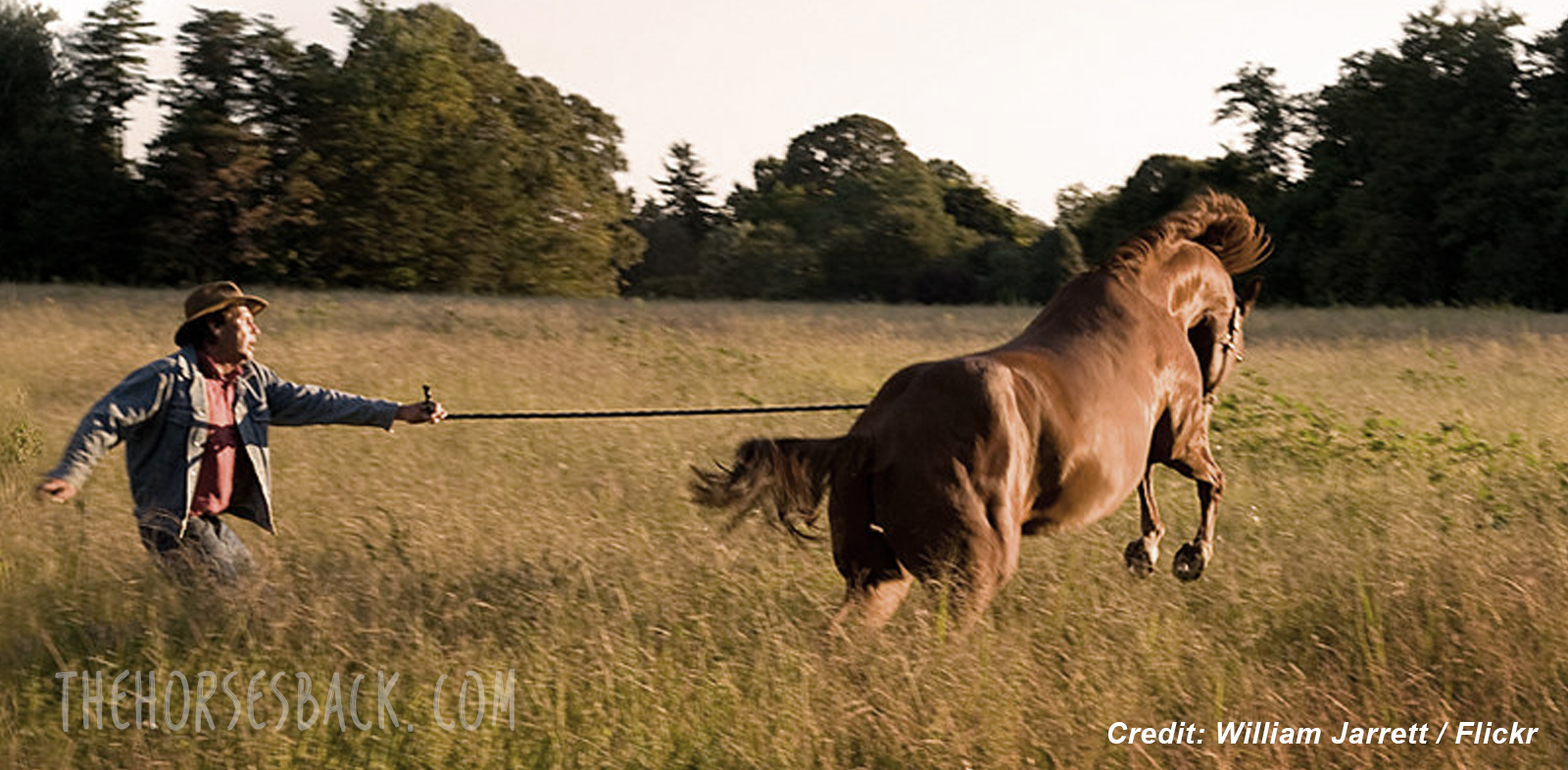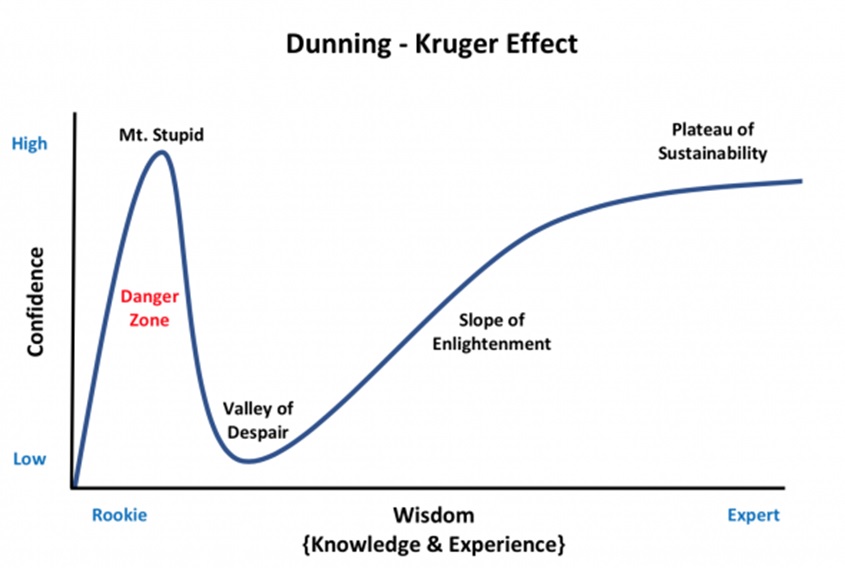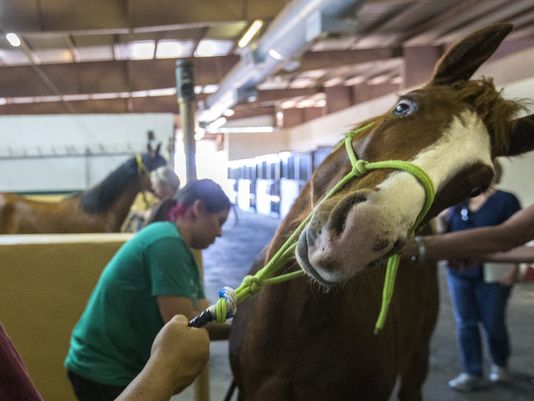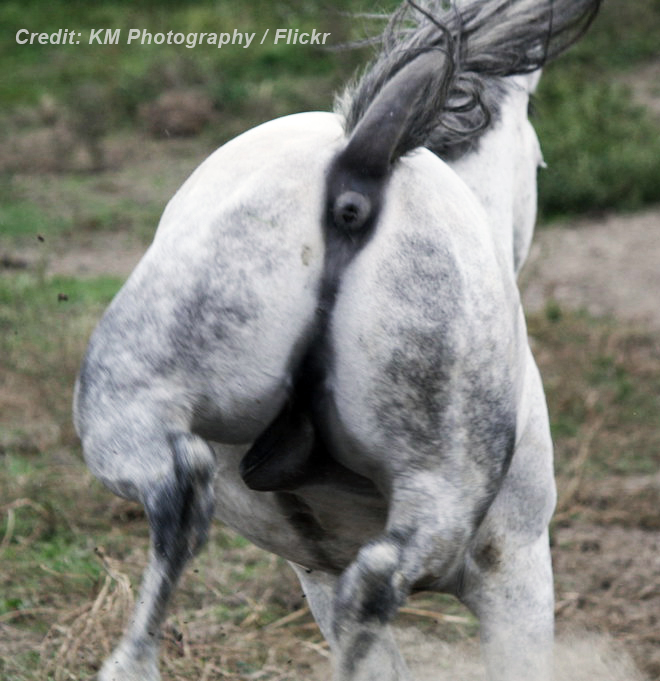
“DUH!!! Scientists are SOOOOO behind the rest of us!”
I read this today and for once, couldn’t just scroll past and forget. Perhaps it’s because it came from an equine professional and, you know, I’d really be hoping for better from someone who partially depends on scientific knowledge for their business.
You all know how it goes. Every so often, a scientific study is published that confirms new findings – this time, about horses’ emotions – and inevitably, the great wise ones on social media drum out the usual statements about how obvious it’s always been to them, blah-di-dah. For the record, if anyone cares, such comments usually make me have two thoughts:
- Someone’s climbing high on Mount Stupid (see Dunning Kruger effect, below).
- It’s time to unfollow Someone.
The sorry truth is that people who respond in this way are simply putting their own ignorance on display. It’s happening everywhere, of course, but here’s what we see in the equine sector. I’m going to use the May 2018 equine science study on horses reading human facial expressions that’s currently being recirculated (read the journal article here) as illustration.

If you run into an equine science basher, remember:
- They may well not have read the information they’re sharing. Often they’re not even sharing the study, but someone else’s post and interpretation of the study findings, which may be misworded. They’ve not read that, either.
- They’ve missed the key points. Yes, they are an expert on their own horse (they believe). Did they happen to notice that this study reported that horses could remember their emotions from photographs? Hmm… it’s unlikely.
-
Plenty of people misinterpret what they’re seeing anyway. In my own area of bodywork, in which I mostly get to meet owners who care and try their best, signs of pain that are obvious to me are frequently missed. I’ll bet every trainer or clinician has an equivalent version.
- Many people aren’t self aware enough to understand the effect their own presence is having on their horse. Again, not if what I’ve seen in bodywork sessions is anything to go by (my current clients are lovely, though!).
© All text copyright of the author, Jane Clothier, https://thehorsesback.com.
Like great food, good equine science is rarely fast.
Here are two major points about equine science.
1. Acquiring scientific evidence is NOT the same thing as having an opinion about your own horse.
2. Science is NOT slow in catching up with your own ‘findings’. Even when you are understanding horses correctly, good science with solid evidence takes time.
Good science can’t be rushed. 
There are so many things to slow it down.
Just take Animal Ethics Committees (most developed countries have their own versions of these). All animal studies have to go through a vigorous assessment as to any stress the procedure might cause the horses, how the stress will be recognized, how stress can be minimized, etc, etc. This takes a time and I imagine most horse owners wouldn’t want studies happening without it.
Then there’s setting the study up, locating the horses, lining up the facilities, analyzing results, writing it up, and getting it published (it can take over a year before a submitted article actually appears in a journal).
The quality is in the detail
Then there are the variables. Horses are subject to so many different experiences acquired through every possible variation of management practice, handling, training, riding and tack, not to mention associated injury or illness. All these things can influence results and compromise findings, which makes setting up equine studies rather more complicated on the animal side than, say, those involving sheep.
There are a huge number of factors to consider. So for example when setting up a ‘horse recognizing human emotions’ study, it must be absolutely clear that:
- The horse isn’t responding to an expectation of feed, rather than the person.
- The horse hasn’t had previous experiences that are making it respond in a particular way (such as pain, bad handling, etc).
- How are the researchers identifying the process of recognition in the horse? Which expressions, facial and otherwise, are the scientists recording?
This is to vastly over-simplify things, but I hope you get the point.
Big studies, small findings
Invariably, it’s often the case that a study can only provide evidence for a couple of apparently simple points.
Equine science studies aren’t “SOOOOO behind”! The researchers are simply taking time to do it properly.
Science costs money and good science costs more money
Research is expensive. Given how complicated studies can be to plan, set up and complete, finding funding can be a hurdle. It’s not simply of behavioral scientists sitting around wondering what to spend their money on next.
Finding money takes more time and that’s if funders want to support the research in the first place.
Why do people ignore the positives?
The bashing comes, I’m sure, from a place of insecurity. People feel that something they’re holding onto is threatened. There’s also the nature of the equine sector: so many people only feel accomplished when they’re pointing to the lack of knowledge of others – we all know it’s endemic. Unfortunately, their critical (but not analytical) eye takes in all comers, including those whose contribution will help them.

It’s also connected with an anti-science view that often comes from those who feel an empathy with horses. It goes along with a whole load of anti-this and anti-that. It gets tiresome after a while and it’s a shame, because it gets in the way of a lot of good information that’s contributing to our collective knowledge.
Now I do understand that certain scientists can be dismissive of many of the subjective experiences we have with our horses. Not everything can be evidenced, not that that means it doesn’t happen – and some things haven’t been evidenced yet. (The best scientists I’ve met acknowledge this and will say, “we don’t know – yet”.)
I’m a complementary therapist with a recent science qualification, so I certainly have a foot on both sides of this particular line. But I really can’t handle this ‘anti’ response from people who should know better, as it totally throws out the baby with the bathwater.
Shouldn’t we be focusing our critical eye on the horse people who don’t acknowledge the significance of horses’ emotions, rather than those who are providing evidence for them?
Shouldn’t we be saying ‘how wonderful that evidence been found for what I believed all along’? Why bash the scientists? Instead of being contemptuous, shouldn’t we be saying ‘thank goodness, life may gradually improve for all horses as evidence is provided for their sentience?’
Because here’s the thing: equine scientists are horse people. They are horse owners, riders and lovers. They’re not remote observers – they ride amongst us! And they care about horses at least as much as you do.
Not all equine science is good science, I’ll agree, yet I’d say it takes a whole lot more analytical engagement to criticize it than “Duh” (that bugged me, can you tell?).
What do you think?
Hi. I met during building up my experience with horses many professionals of the horse world, farmers interested in horsesport, breeders, horse owners and riders and scientists. A few open minded. It’s astonishing how people argue with outdated arguments, farmers as well as riders, “we have done it for 50 years, we don’t change anything”. Scientist work is sometimes of no practical value. The most important impact to take the next step for a better world for horses are the philosophers under us. They give good arguments to change our point of view. This created Horsemanship. This created a non violent approach to horses. They are not our slaves and violence is never the right answer to a problem.
“Scientist work is sometimes of no practical value.”
True, but sometimes studies are like the base blocks in a pyramid, as another study will build upon it, and another upon that… and one of these will have direct application.
Not all the work of philosophers is applicable, but knowledge developed in different fields is integrated to inform our practices with horses.